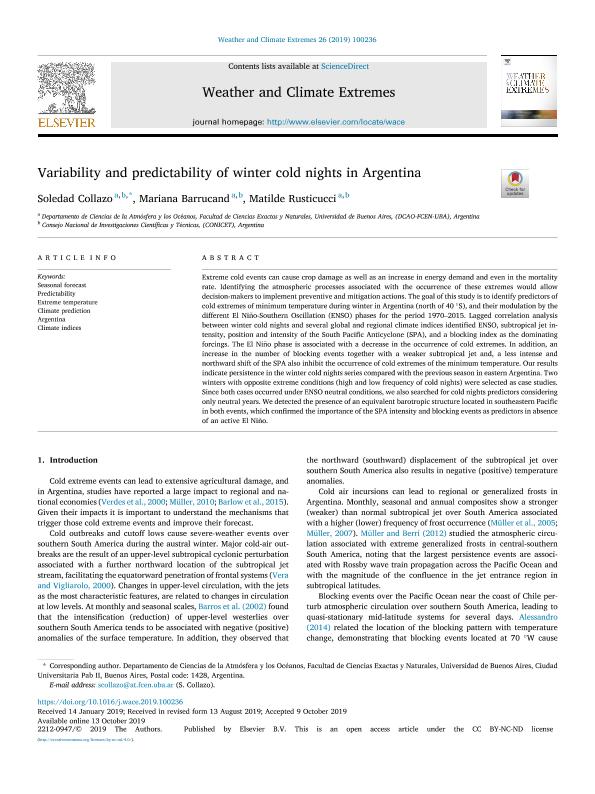Mostrar el registro sencillo del ítem
dc.contributor.author
Collazo, Soledad Maribel

dc.contributor.author
Barrucand, Mariana Graciela

dc.contributor.author
Rusticucci, Matilde Monica

dc.date.available
2021-12-14T01:20:26Z
dc.date.issued
2019-10
dc.identifier.citation
Collazo, Soledad Maribel; Barrucand, Mariana Graciela; Rusticucci, Matilde Monica; Variability and predictability of winter cold nights in Argentina; Elsevier; Weather and Climate Extremes; 26; 100236; 10-2019; 1-15
dc.identifier.issn
2212-0947
dc.identifier.uri
http://hdl.handle.net/11336/148662
dc.description.abstract
Extreme cold events can cause crop damage as well as an increase in energy demand and even in the mortality rate. Identifying the atmospheric processes associated with the occurrence of these extremes would allow decision-makers to implement preventive and mitigation actions. The goal of this study is to identify predictors of cold extremes of minimum temperature during winter in Argentina (north of 40 °S), and their modulation by the different El Ni~no-Southern Oscillation (ENSO) phases for the period 1970?2015. Lagged correlation analysis between winter cold nights and several global and regional climate indices identified ENSO, subtropical jet intensity, position and intensity of the South Pacific Anticyclone (SPA), and a blocking index as the dominating forcings. The El Niño phase is associated with a decrease in the occurrence of cold extremes. In addition, an increase in the number of blocking events together with a weaker subtropical jet and, a less intense and northward shift of the SPA also inhibit the occurrence of cold extremes of the minimum temperature. Our results indicate persistence in the winter cold nights series compared with the previous season in eastern Argentina. Twowinters with opposite extreme conditions (high and low frequency of cold nights) were selected as case studies. Since both cases occurred under ENSO neutral conditions, we also searched for cold nights predictors consideringonly neutral years. We detected the presence of an equivalent barotropic structure located in southeastern Pacific in both events, which confirmed the importance of the SPA intensity and blocking events as predictors in absenceof an active El Niño.
dc.format
application/pdf
dc.language.iso
eng
dc.publisher
Elsevier

dc.rights
info:eu-repo/semantics/openAccess
dc.rights.uri
https://creativecommons.org/licenses/by-nc-nd/2.5/ar/
dc.subject
SEASONAL FORECAST
dc.subject
PREDICTABILITY
dc.subject
EXTREME TEMPERATURE
dc.subject
CLIMATE PREDICTION
dc.subject
ARGENTINA
dc.subject
CLIMATE INDICES
dc.subject.classification
Meteorología y Ciencias Atmosféricas

dc.subject.classification
Ciencias de la Tierra y relacionadas con el Medio Ambiente

dc.subject.classification
CIENCIAS NATURALES Y EXACTAS

dc.title
Variability and predictability of winter cold nights in Argentina
dc.type
info:eu-repo/semantics/article
dc.type
info:ar-repo/semantics/artículo
dc.type
info:eu-repo/semantics/publishedVersion
dc.date.updated
2020-12-16T18:34:26Z
dc.journal.volume
26
dc.journal.number
100236
dc.journal.pagination
1-15
dc.journal.pais
Países Bajos

dc.description.fil
Fil: Collazo, Soledad Maribel. Universidad de Buenos Aires. Facultad de Ciencias Exactas y Naturales. Departamento de Ciencias de la Atmósfera y los Océanos; Argentina. Consejo Nacional de Investigaciones Científicas y Técnicas; Argentina
dc.description.fil
Fil: Barrucand, Mariana Graciela. Universidad de Buenos Aires. Facultad de Ciencias Exactas y Naturales. Departamento de Ciencias de la Atmósfera y los Océanos; Argentina. Consejo Nacional de Investigaciones Científicas y Técnicas; Argentina
dc.description.fil
Fil: Rusticucci, Matilde Monica. Universidad de Buenos Aires. Facultad de Ciencias Exactas y Naturales. Departamento de Ciencias de la Atmósfera y los Océanos; Argentina. Consejo Nacional de Investigaciones Científicas y Técnicas; Argentina
dc.journal.title
Weather and Climate Extremes
dc.relation.alternativeid
info:eu-repo/semantics/altIdentifier/doi/http://dx.doi.org/10.1016/j.wace.2019.100236
dc.relation.alternativeid
info:eu-repo/semantics/altIdentifier/url/https://www.sciencedirect.com/science/article/pii/S2212094719300040
Archivos asociados
